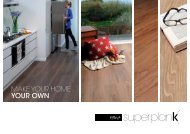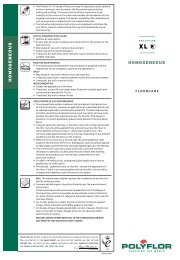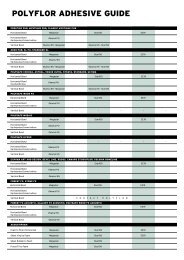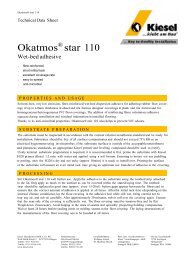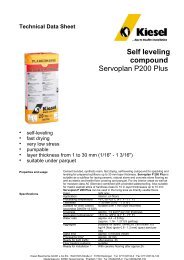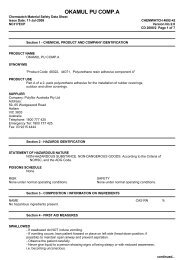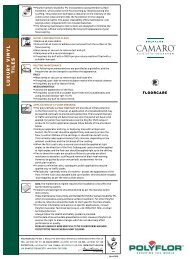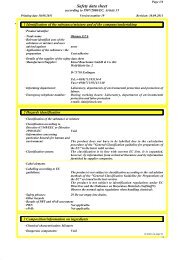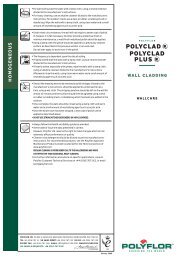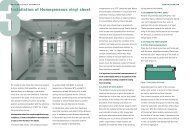Safety Solutions Brochure - Polyflor
Safety Solutions Brochure - Polyflor
Safety Solutions Brochure - Polyflor
Create successful ePaper yourself
Turn your PDF publications into a flip-book with our unique Google optimized e-Paper software.
30<br />
Slip Resistance<br />
Slip resistance can be a confusing area for specifier<br />
and client alike. On one hand there is a requirement to<br />
specify flooring that is safe and fit for use, against a<br />
background of increasing awareness and litigation in<br />
the case of slips and trips. On the other hand, there is a<br />
plethora of test methods to assess the slipperiness of<br />
floors, various manufacturer claims and competing<br />
product to complicate choice. Add in colour choice,<br />
decoration and maintenance and the confusion can<br />
multiply.<br />
<strong>Polyflor</strong> would always give the same two key points of<br />
advice before slip resistant flooring is specified.<br />
1. Use a reputable manufacturer that can demonstrate<br />
previous experience in areas you are working on.<br />
2. Ask for advice – the team at <strong>Polyflor</strong> have more<br />
experience in this area than any one individual could<br />
acquire. The Customer Technical Support Team is on<br />
hand to dispense free advice – please use them.<br />
REMEMBER – over specifying on slip resistance does<br />
not necessarily give the safest floor.<br />
When carrying out initial risk assessments to determine<br />
the factors that could cause slip risks and implementing<br />
pre-emptive measures to minimise these risks, the<br />
specification of appropriate flooring should not be<br />
seen as the sole, one dimensional solution. The Health<br />
and <strong>Safety</strong> Executive (HSE) points to other factors<br />
having an impact on the risk of slipping - these include:<br />
the type of footwear used, drainage and expected floor<br />
contaminants, likely cleaning regimes as well as the<br />
different types of use the floor is subjected to by<br />
pedestrians, including individual gaits and human<br />
behaviour when walking.<br />
The HSE Slip potential model<br />
SLIPS AND TRIPS<br />
According to HSE research:<br />
• Slips and trips are the single most common cause of<br />
major injuries in the United Kingdom<br />
workplace, accounting for 1 in 3 major injuries per<br />
annum (37% of all occupational injury accidents)<br />
• Over 8500 major injuries are suffered each year at a<br />
cost to the economy of £750 million each year<br />
• A cost of £512 million is felt by employers in lost<br />
production and other costs each year.<br />
More information on HSE’s ongoing campaign to reduce<br />
the number of slips and trips can be viewed on<br />
www.hse.gov.uk/slips.<br />
SLIP RESISTANCE TEST METHODS<br />
<strong>Polyflor</strong> tests Polysafe products against a variety of<br />
international test methods for slip resistance and the<br />
results are published for all to see.<br />
The test methods explained here are the most relevant<br />
and commonly used to make precision assessment of<br />
floor slipperiness.<br />
RRL PENDULUM CO-EFFICIENT OF FRICTION TEST<br />
This test method is recommended and preferred by the<br />
HSE to assess the dynamic coefficient of friction of a<br />
floorcovering, achieved by swinging a dummy heel over<br />
the floor surface (see opposite page, top left) to<br />
simulate a foot slipping on a wet floor. A standardised<br />
rubber soiling sample is used to represent a standard<br />
shoe sole of average slip resistance. Widely used, the<br />
greatest strength of this test is that it can easily be used<br />
in-situ, so the slip resistance of the floor can be<br />
assessed over its whole life.<br />
Results are quoted using a Four S (Slider 96) rubber<br />
slider. Whilst floor surfaces can be tested in the wet or<br />
dry, the results indicated on Polysafe always quote the<br />
wet result as this is the condition in which slipping is<br />
likely to occur. Be wary of very high dry results quoted<br />
in isolation.<br />
HSE Guidelines call for a floor to give a Pendulum test<br />
value of 36 and above in the wet to be classified as a<br />
low slip risk.



